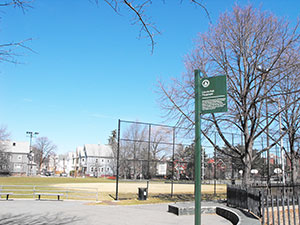
Many in the community feel that natural grass is the best way to go for the playing fields of Lincoln Park, while artificial turf proponents continue to press their case. — Photo by Bobbie Toner
By Mariya Manzhos
The City of Somerville’s plan to install synthetic turf at Lincoln Park has spurred a vibrant discussion among a group of residents who wish to preserve the natural grass.
Over the last three weeks, the natural grass proponents gathered 671 signatures in support of keeping grass. The petition was presented at the Board of Aldermen meeting on August 27.
Jason Suderman, a local business owner and father of a child entering the Argenziano School, addressed the Board of Aldermen on behalf of the group, calling on the city to preserve “the largest continuous, totally natural public common space in Somerville.”
“Many Somerville residents have had the singular opportunity of feeling natural grass between their toes. Through this park we can connect with the little natural preserve left in this densely populated city. How can we as a city condone the destruction?” said Suderman passionately in his address.
Since the Argenziano School was opened in 2007, Lincoln Park has seen significant wear and tear. Given the city’s dense population and scarcity of open space, the field is being used by adult kickball teams, students from Newbury College and Lesley University and other teams from outside the city.
Jason Harty has owned a home on the street down from Lincoln Park since 2007 and recalls that only a few times has the entire field been filled with grass. “Whether poorly managed or overly loved, it’s been heavily played on. I walk my dog there every day. It’s always dusty and there are patches of dirt.”
“What we have out there now is an incredibly substandard athletic surface, it is rutted, it is dangerous, there is all sorts of rocks and undulations out there. The kids are turning their ankles, the grass will not grow, it is a dust bowl. It is a sad state of affairs,” says Cheri Ruane, Vice President at Weston & Sampson landscape design firm, which submitted one of the three proposals to install artificial turf at Lincoln Park.
The park was poorly engineered, according to a Weston & Sampson’s assessment and didn’t originally have a quality medium for the grass to grow.
While natural grass proponents agree that the field is in desperate need of repair, they believe that by limiting the uses of the field and with proper care, grass can be a sustainable surface for the athletic and community needs of the park.
“Because we have a growing need in the city, we need to think more strategically and even a little bit more selfishly about how we use and allocate the ways that we use our open space. We need to prioritize,” said Ward 2 Alderman Maryann Heuston at the Board meeting. She clarified that limiting access only to Somerville residents may sufficiently decrease the use and allow the preservation of grass.
“It’s an ill-conceived notion that the park should be a catch-all for the city’s many sports programs, as well as many from the outside the city limits,” said Suderman in the meeting.
Ruane from Weston & Sampson agrees that the field at Lincoln Park is over-permitted, but believes that turning the teams away is still not enough to keep the grass in the shape it needs to be in to meet the Somerville’s increasing demands for the field’s’ performance.
With soccer leagues, softball teams and the Argenziano’s recess, the grass field will be dead in two years, Ruane estimates. Studies show that a natural grass athletic field can’t endure more than 400-500 hours a year while remaining a safe surface to play on. In 2012, according to Ruane, Lincoln Park field was used around 2000 hours a year. “Even with restraining access to teams from outside the city and adults, we’ll be at around 1000 hours – you’re still close to double of what natural grass can support,” Ruane says.
Natural grass enthusiasts are also concerned with potential risks associated with toxicity of crumb rubber and the extreme high temperatures artificial turf reaches in the summer. Renée Scott, member of Green and Open Somerville, acknowledges that there are no conclusive studies about toxicity of artificial turf, but feels strongly about the issue of heat. “My son plays youth soccer on artificial turf. The other day it was high 80’s and these boys who never want to be taken out of the game were begging their coach to sit down, because their feet were too hot,” says Scott. To see for herself, she took a reading on the artificial turf hill at the base of the East Somerville community school on an 85 degree day and it showed 128 degrees.
Ruane, also a mother of two kids who attend the Argenziano School, says she would rather have her kids play on grass, but it’s not an option for Somerville given the high demand of the field. “We’d rather design natural grass fields and we do so in communities that have the open space inventory,” says Ruane.
According to Ruane, the decision to install natural turf prioritizes the healthy and active lifestyle of the community by ensuring the hours of play that are so necessary to prevent obesity. Ruane says they are trying to mitigate the concerns about toxicity of turf material and heated surface. The engineers are proposing to use non-toxic virgin rubber infill and a more reflective color of turf to lower the temperature.
According to the firm’s proposal, 15% of Lincoln Park would be artificial turf while the other 85% of the park is ecologically ambitious. The engineers plan to capture and filter storm water and use it to build rain gardens and allow adventure play in an outdoor classroom. The plan also involves planting an additional 150 trees. “The park is going to be so much more ecologically strong and in support of what can be green and open Somerville,” says Ruane.
But Alderman Heuston remains skeptical. With the school on one side and dense neighborhood on the other, what happens at Lincoln Park will have an immediate impact on that neighborhood. She is afraid that the artificial turf field may change the park’s character by making it a de facto athletic facility constantly occupied by the teams.
“We’re asking the city to take a step back and be more thoughtful about how we use open space in this city, rather than jumping into things because we have a need and we have to accommodate it and do the most expedient thing that we can do,” said Heuston at the meeting.
City spokesperson Denise Taylor wrote in an email to The Somerville Times that “City park planning staff are currently developing recommendations for the fields at Lincoln Park based on field use data, community feedback, and recommendations from landscape design consultants Weston & Sampson Engineers, Inc./SPURR.” Once the Mayor reviews and approves the recommendations they will be presented to the community at the next Lincoln Park planning meeting, expected to be held late September/early October.















Reader Comments